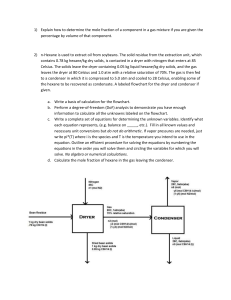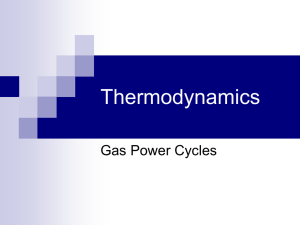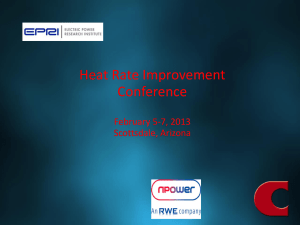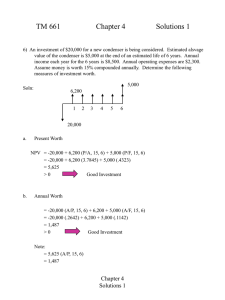Keywords – Household refrigerator, wire-on-tube
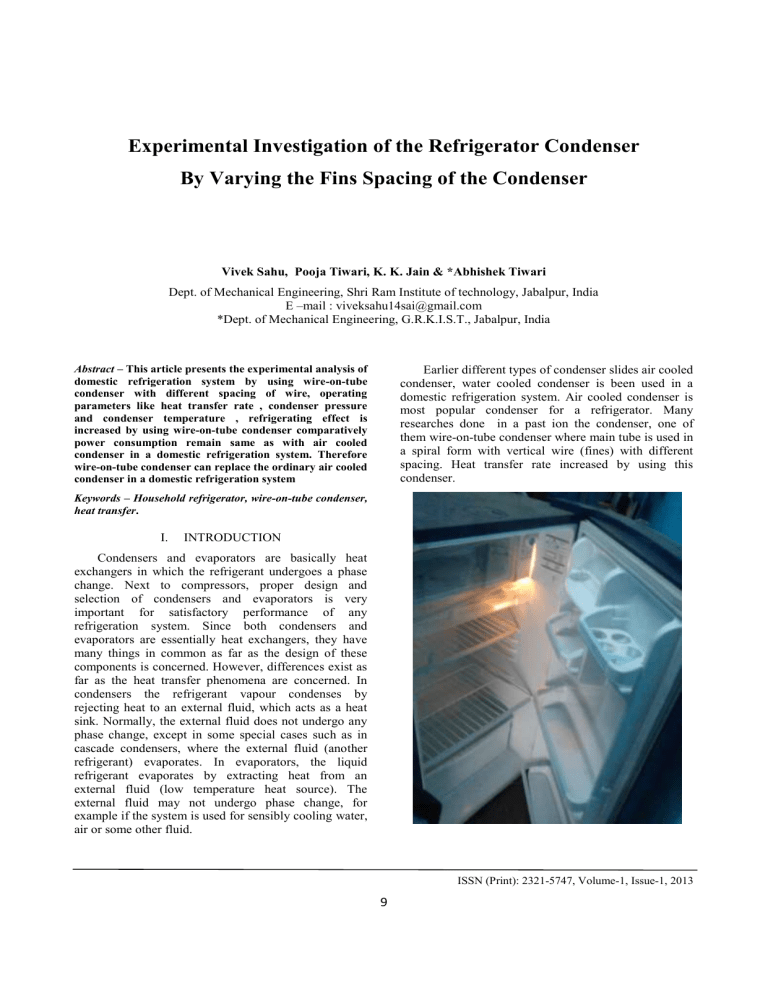
Experimental Investigation of the Refrigerator Condenser
By Varying the Fins Spacing of the Condenser
Vivek Sahu, Pooja Tiwari, K. K. Jain & *Abhishek Tiwari
Dept. of Mechanical Engineering, Shri Ram Institute of technology, Jabalpur, India
E –mail : viveksahu14sai@gmail.com
*Dept. of Mechanical Engineering, G.R.K.I.S.T., Jabalpur, India
Abstract – This article presents the experimental analysis of domestic refrigeration system by using wire-on-tube condenser with different spacing of wire, operating parameters like heat transfer rate , condenser pressure and condenser temperature , refrigerating effect is increased by using wire-on-tube condenser comparatively power consumption remain same as with air cooled condenser in a domestic refrigeration system. Therefore wire-on-tube condenser can replace the ordinary air cooled condenser in a domestic refrigeration system
Earlier different types of condenser slides air cooled condenser, water cooled condenser is been used in a domestic refrigeration system. Air cooled condenser is most popular condenser for a refrigerator. Many researches done in a past ion the condenser, one of them wire-on-tube condenser where main tube is used in a spiral form with vertical wire (fines) with different spacing. Heat transfer rate increased by using this condenser.
Keywords – Household refrigerator, wire-on-tube condenser,
heat transfer.
I. INTRODUCTION
Condensers and evaporators are basically heat exchangers in which the refrigerant undergoes a phase change. Next to compressors, proper design and selection of condensers and evaporators is very important for satisfactory performance of any refrigeration system. Since both condensers and evaporators are essentially heat exchangers, they have many things in common as far as the design of these components is concerned. However, differences exist as far as the heat transfer phenomena are concerned. In condensers the refrigerant vapour condenses by rejecting heat to an external fluid, which acts as a heat sink. Normally, the external fluid does not undergo any phase change, except in some special cases such as in cascade condensers, where the external fluid (another refrigerant) evaporates. In evaporators, the liquid refrigerant evaporates by extracting heat from an external fluid (low temperature heat source). The external fluid may not undergo phase change, for example if the system is used for sensibly cooling water, air or some other fluid.
ISSN (Print): 2321-5747, Volume-1, Issue-1, 2013
9
International Journal on Mechanical Engineering and Robotics (IJMER)
Fig. 3 Schematic of a Double pipe (tube-in-tube) type condenser & shell & coil type condenser used in small refrigeration systems.
6mm spacing
Fig. 1. Finned tube condenser used for experimental study
II. TYPES OF CONDENSERS
Fig. 2 Schematic of a wire-and-tube type & plate fin type condenser r used in small refrigeration systems
10
3mm spacing
ISSN (Print): 2321-5747, Volume-1, Issue-1, 2013
International Journal on Mechanical Engineering and Robotics (IJMER)
9mm spacing
III. LITERATURE REVIEW
1. Bansal et alexperimental analysis is done by using wire-on-tube condenser in a refrigerator with different operating parameters and compare these results with a simulation modeling finally they optimized the condenser performance.
2. Looza et alevaluated the performance of wire-ontube condenser with the help of basic operating parameters and compare with different fin design of condenser.
3. Hoke et althey have performed with seven different spacing with wire-on-tube condenser for increasing the air heat transfer rate during operating this experiment new type of coil and heat exchanger is usded.
4. Tanda et althey investigated a Nusselt number and operating parameters for predicting the free convections heat transfer from a wire-on-tube condenser.
5. Reeves et althe demonstrated the domestic refrigerator performance under of conditions , by using different instrumentations with different range of room temperature.
6. Lee et al he developed heat transfer coefficient for wire-on-tube condenser using single layers.
IV. OPTIMIZATION OF CONDENSER
In the past single coil air cooled condenser was used by the refrigerator companies, as the time progressed many changes is done by the researchers to enhance the performance of the condenser, different types of fines and coils with different shapes is now been used to increased the heat transfer rate by the air cooled condenser. Coils having different diameter also been used to increased then over all COP of the vapour compression refrigeration system.
Results & discussion:
Graph 1.1: Variation of discharge pressure with time for condenser spacing of 3mm, 6mm & 9 mm
ISSN (Print): 2321-5747, Volume-1, Issue-1, 2013
11
International Journal on Mechanical Engineering and Robotics (IJMER)
Fig. 1.1 shows the variation of discharge pressure with time for Different condenser spacing. As shown in the figure, the maximum short-time discharge pressure within the first 20 min of starting the Compressor runs up to, after which the pressure reduced and stabilized.
At steady-state conditions the discharge pressures for 3 mm, 6 mm, 9 mm were 36.12, 34.42 and 32.43 bar, respectively. can’t say thank you enough for his tremendous support and help. I feel motivated and encouraged every time I attend his meeting. Without his encouragement and guidance this project would not have materialized. I am also thankful to Dr. L.K. Patel , Principal Shri Ram
Institute of Technology, Jabalpur, for permitting me to avail the facilities needed for this work. I am highly indebted to my special guidance Dr. R. K. Dave , PG
Course Director. Shri Ram Institute of Technology, for his untiring devotion, great patience and keen interest in giving the knowledge and guidance needed.
I express my sincere thanks to Mrs. Pooja Tiwari ,
(Co Guide & Prof.),Shri Ram Institute of Technology,
Jabalpur, for his kind support and valuable suggestions wherever necessary .
Graph 1.2. Variation of discharge pressure with time for condenser spacing of 3mm, 6mm & 9 mm
Fig.1.2 shows the variation of discharge pressure with time for Different condenser spacing. As shown in the figure, the maximum short-time discharge pressure within the first 20 min of starting the Compressor runs up to, after which the pressure reduced and stabilized.
At steady-state conditions the discharge pressures for 3 mm, 6 mm, 9 mm were 36.12, 34.42 and 32.43 bar, respectively.
V. CONCLUSION
1. Discharge pressure of 9mm fins spacing is about the same with that of 6mm fins spacing with average percentage reduction of 5.7%. The discharge pressure of 3mm fins spacing was the highest with average value of 4.7% and 10.2% higher than those of 6mm fins spacing and 9mm fins spacing respectively.
2. At steady-state conditions the discharge pressures for 3 mm, 6 mm, 9 mm were 34.41, 32.00 and
30.56 bar, respectively.
VI. ACKNOWLEDGMENT
I would like to show my greatest appreciation and wholehearted thanks to my guide Prof. K. K. Jain I
VII. REFERENCE
1. Numerical analysis and experimental investigation into the performance of a wire-ontube condenser Ahmadul Ameen et al
International Journal of Refrigeration 29 (2006)
495–504.
2. B. Khastoo, Design and optimization of Iranian refrigerators, Research report in Amirkabir
University, vol II, 2001.
3. S. Porkhial, Experimental and mathematical modeling of transient behavior of a domestic refrigerators (improving in refrigerator performance), Ph.D. Thesis, Amirkabir
University, Mechanical Engineering Department,
2003.
4. B. Palm, Refrigeration systems with minimum charge of refrigerant, App.Therm. Eng. 27 (2007)
1693–1701.
5. T. Dutto, J.C. Blaise, T. Benedic, Performances of brazed plate heat exchanger set in heat pump, in: Proceedings of the 18th Int. Congr. Refrig.,
Montreal, Canada, 1991, pp. 1284–1288.
6. M.A. Kedzierski, Effect of the inclination on the performance of a compact brazed plate heat exchanger, Heat Transfer Eng. 18 (1997) 25–38.
7. Lesson 22 Condenser & Evaporator Version 1
ME, IIT Kharagpur 1.
8. A text book of refrigeration and air conditioning by R.S. KHURMI et al
ISSN (Print): 2321-5747, Volume-1, Issue-1, 2013
12

